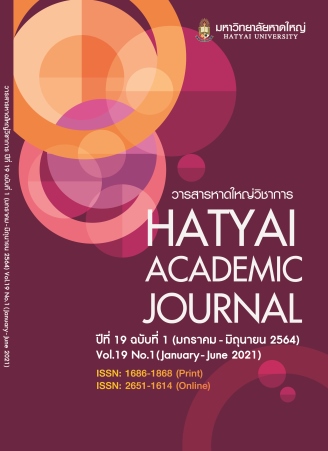A Model of Factors Controlling the Financial Well-being of Earners in Northeastern Thailand
Main Article Content
Abstract
This research examines the influence of personal factors regarding financial status, socialization, financial literacy, financial self-efficacy, and financial behavior on financial well-being and studies the causal relationship between factors that control the financial well-being of the earners. The application of two-stage sampling obtained a cluster of 506 income earners who are income earners registered in the social security registration system of the Northeastern region. The data were analyzed using structural equation modeling. The results show that financial behavior has a direct impact on financial well-being. Other indirect influential factors on financial well-being, with respective levels of significance, include financial behavior, financial literacy, and socialization. It is further revealed
that financial literacy and financial self-efficacy have a significant direct impact on financial behavior. The model of factors controlling the financial well-being
of the income earners fits with the empirical data. The results suggest that financial literacy and financial self-efficacy can provide desirable financial behavior which can lead to good financial well-being. Therefore, the government and private sectors should support and promote financial literacy to help income earners to have good financial well-being. The promotion is to help to build a financial habit of saving, investing, and ensuring financial risk among the earners including channels to access the financial knowledge with ease and accuracy.
Article Details
All published articles are evaluated by three qualified peer reviewers from various institutions through a double-blind process, where reviewers do not know the authors’ identities and authors do not know the reviewers’ identities. The content and articles in the Hatyai Academic Journal reflect the authors’ views only and are neither the opinions of the editorial board nor the responsibility of Hatyai University. The Editorial Board of the Hatyai Academic Journal allows articles to be reproduced for academic purposes, on the condition that the original source is clearly cited.
References
Asebedo, S. (2016). Financial self-efficacy beliefs and the saving behavior of older pre-retirees (Doctoral dissertation). Kansas State University, Manhattan, Kansas.
Bank of Thailand. (2014). Thailand financial literacy survey 2013 report. Retrieved from http://www.1213.or.th [in Thai]
Bank of Thailand. (2017). Thailand economics report 2017. Retrieved from https://www.bot.or.th [in Thai]
Brounen, D., Koedijk, E. K., & Pownall, R. (2016). Household financial planning and savings behavior. Journal of International Money and Finance, 69(1), 95-107.
Consumer Financial Protection Bureau. (2015). Financial well-being: The goal of financial education. Washington D.C.: CFPB.
Dew, J., & Xiao, J. J. (2011).The financial management behavior scale: Development and validation. Journal of Financial Counseling and Planning, 22(1), 43-59.
Farrell, L., Fry, R. L., & Risse, L. (2016). The significance of financial self-efficacy in explaining women’s personal finance behavior. Journal of Economic Psychology, 59(1), 85-99.
Fluellen, V. M. (2013). Exploring the relationship between financial behaviors and financial well-being of African American college students at one historically black institution (Doctoral dissertation). Iowa State University, Ames, Iowa.
Gutter, M. S. (2000). Human wealth and financial asset ownership. Journal of Financial Counseling and Planning, 11(2), 9-19.
Hair, J. F., Black, C. W., Babin, J. B., & Anderson E. R. (2014). Multivariate data analysis: A global perspective (7th ed.). New Jersey: Pearson Prentice Hall.
Huston, S. J. (2010). Measuring financial literacy. The Journal of Consumer Affairs, 44(2), 296-316.
Kempson, E., Finney, A., & Poppe, C. (2017). Financial well-being a conceptual model and preliminary analysis (Research report). Norway: Oslo and Akershus University.
Kempson, E., & Poppe, C. (2018). Understanding financial well-being and capability a revised model and comprehensive analysis (Research report). Norway: Oslo and Akershus University.
Lown, J. (2011). Development and validation of a financial self-efficacy scale. .Journal of Financial Counseling and Planning, 22(2), 54-63.
Ministry of Labor. (2017). Basic data of labor in northeast Thailand 2017. Retrieved from https://www.doe.go.th/prd/assets/upload/files/lmine_th/513857130f592b701ece4ad079a2c4.pdf [in Thai]
Noonin, S., & Phuangprayong, K. (2018). Factors affecting lifestyle of young generation in Thai rural society. Journal of Social Development, 44(2), 34-64. [in Thai]
Nusith, A., Rachapradit, P., Jampachisri, K., & Adereksombat, K. (2014). Factors explaining retirement saving adequacy for employees in Thailand. Journal of Business Administration, 37(114), 39-52. [in Thai]
Office of the National Economic and Social Development Council. (2018). Thailand population income-expenses statistic 1987-2017. Retrieved from http://social.nesdb.go.th/social /Default.aspx?tabid =131 [in Thai]
Potisita, C. (2012). Thai countryside in a capitalist way. The Journal of the Royal Institute of Thailand, 37(4), 163-185. [in Thai]
Rooij, M. C., Lusardi, A., & Alessie, R. J., (2012). Financial literacy, retirement planning and household wealth. Economic Journal, 122(560), 449–478.
Sabri, M. S. (2011). Pathways to financial success: Determinants of financial literacy and financial well-being among young adults (Doctoral dissertation). Iowa State University, Ames, Iowa.
Schumacker, R. E., & Lomax, R. G. (2010). A beginners guide to structural equation modeling: SEM. New Jersey: Lawrence Erlbaum Associates.
The Committees of the Nation Reform Steering Assembly. (2016). The reform of the fundamental knowledge on finance for Thai people. Retrieved from http://library2.parliament.go.th/giventake /content_nrsa2558/d100359-01.pdf [in Thai]
Wanichbancha, K. (2014). Structural Equation Modeling (SEM) with AMOS (2nd ed.). Bangkok: Samlada. [in Thai]
Xiao, J. J., Chen, C., & Chen, F. (2013). Consumer financial capability and financial satisfaction. Social Indicator Research, 118(1), 415-432.
Xiao, J. J., Ford M. W., & Kim, J. (2011). Consumer financial behavior: An interdisciplinary review of selected theories and research. Family and Consumer Sciences Research Journal, 39(4), 399-414.
Xiao, J. J., & Porto, N. (2017). Financial education and financial satisfaction: Financial literacy, behavior and capability as mediators. International Journal of Bank Marketing, 35(5), 805-817.

